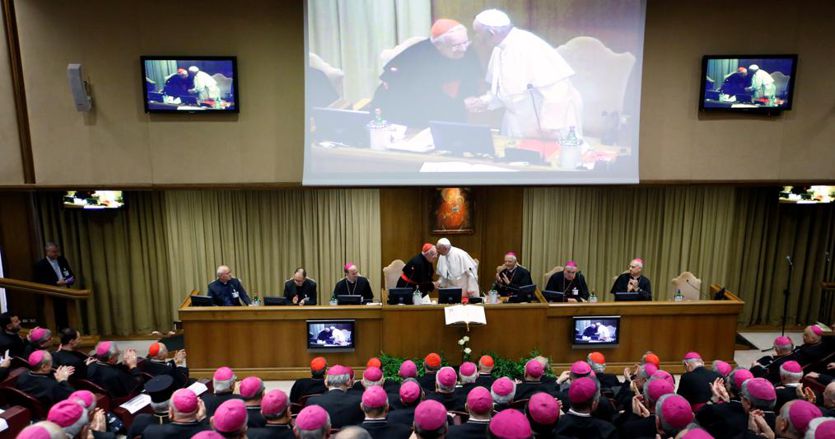The appointment is at the end of May. When the general assembly of the Italian Episcopal Conference is called to renew the president: Cardinal Gualtiero Bassetti, who has headed the CEI since 2018, turns 80 and has to leave. For decades, the president of the CEI was appointed directly by the Pope – an exception, given that in the world it is an election by the episcopal base – and Francis had demanded a reform that was passed directly by the prelates. “Electoral” reform that had been approved (not without difficulty and resistance): since last time the assembly has voted a trio of names from which the Pope chooses. And so it went in 2018, with the indication of Bassetti, who was known to be by far Bergoglio’s favorite.
The two favored cardinals are Roman ex-auxiliaries of the Vicariate
Since he was elected Pope, Bergoglio has profoundly changed the leadership structure of the Italian Church. The leaders of most of the main dioceses have been renewed: now the appointment of the new archbishop of Turin (the current one never appointed cardinal by Francis) is expected shortly, and later Florence. What hypotheses are considered the most likely for the new president? For some time, three names have been permanently circulating in the ecclesial environment: Cardinals Matteo Zuppi (Bologna) and Augusto Paolo Lojudice (Siena) and Archbishop Erio Castellucci (Modena). All three are of Bergoglian nomination, and from experience and ideas in harmony with the pastoral line of the Pope. Zuppi and Lojudice are former auxiliaries of the Vicariate of Rome with a start as parish priests on the outskirts of the capital (the first with a path inside the Community di Sant’Egidio), Castellucci, from Romagna, is a theologian with a high level path. The three names are certainly pleasing to the Pope, and this will influence the preferences of the 232 bishops called to vote, but it is possible that outsiders both from the progressive and more traditionalist areas (by now they are few and quite secluded).
In 2020, the clash over the post-lockdown reopening of masses
Certainly the new president of the CEI – which has Msgr. Stefano Russo – will have to deal with a political-institutional situation in Italy undergoing strong change, starting with the Presidency of the Republic – except for twists – and perhaps the government, and in any case there will be a new Parliament in 2023. On the table there will be no there are real state-church disputes, even if clashes can break out at any moment, as happened during the 2020 lockdown (memorable is the document against the Conte government on the exclusion of religious celebrations from reopening, on which the Pope intervened directly to close the litigation) or on the recurring issue of the IMU. The very hard battle against Count I over the security decree wanted by Minister Salvini belongs to the past.
The “political” pressures of the CEI (and the Holy See) on euthanasia and the Zan ddl
The Italian Church is going through a long phase of transition that began coinciding with the end of the Berlusconi era and with the decline of the influence of Cardinal Camillo Ruini and his long season (started in 1985 in the historic ecclesial conference in Loreto where the turning point was sanctioned interventionist enterprise by Wojtyla and implemented by Ruini). From that moment a process of normalization of relations with Italian politics began, wanted by Francesco elected in 2013 and shared by the new ruling class, first Enrico Letta and then Matteo Renzi. Season in which legislation unthinkable until a few years earlier, such as civil unions or living wills, was introduced. The CEI is contesting both the referendum for the introduction of euthanasia or the Zan bill (the Holy See intervened directly on this, perhaps also due to a certain absence of the Conference, it has been said), but it is clear that the stops are not effect of ecclesiastical pressures, but of completely autonomous political dynamics.
The turning point of Florence in 2015: “Enough of wealth and power”
The Bergoglian turning point for the Italian Church is traced back to 2015 in Florence, when the Pope speaking to the bishops clearly said: “Enough of riches with power” indicating a path that many prelates struggled to take or even to imagine. At other times he returned to these issues: Castellucci, who is also vice president of the CEI, said that to give body “to a different Church a true conversion is needed, because without it it would only be an external reconstruction, an embellishment”. Hence also a structural change, at the formative level, in setting up, in organization, but above all in evangelization. All this will be discussed in the very long journey started with the Synod of the Italian Church, which began in 2021 and will end in 2025, with the year of the Jubilee, a key event for the pontificate of Francis and a stress test for the Italian church called to act as a “Container” but also as a “multiplier” of the event. Next February the Pope will be in Florence for the meeting of the bishops and mayors of the Mediterranean, an appointment considered sensitive for the future structure of the CEI.
